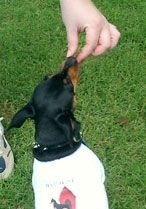To say that Miniature Pinschers can be a handful is an understatement, as any Min Pin owner knows. Miniature Pinschers are headstrong, energetic, and think for themselves. However, Miniature Pinschers can be trained to be calm, well-disciplined dogs. Here, I discuss training Min Pins, but the same strategy can be applied to all dog breeds or almost anything with a pulse, e.g., your spouse, children, extended family, friends, or people in general.
When teaching a dog a command, first one trains the dog to associate the behavior with the word. For some dogs, this is all that is necessary, and the dog will obey the command every time. For other dogs (like Min Pins), a second step is necessary: Make the dog obey every time just because you say so. This can be very frustrating, but with the steps outlined in later posts, it is possible, and even enjoyable.
Min Pin training: it’s so easy in the beginning
In this video, a Min Pin owners demonstrates the the intelligence of the Miniature Pinscher–learning what commands mean in a short time.
Jack – Red Miniature Pinscher
What he hasn’t encountered yet is convincing the Min Pin that it must do the command just because the owner says so.
Min Pins, especially puppies, can be a handful. To have a well-behaved Miniature Pinscher, training advice can be especially helpful. Obedience classes, DVDs, and reading can all be sources of good information.








3 comments
Shawn McFerrin
March 31, 2018 at 5:18 am (UTC 0) Link to this comment
How can I get my min pin to come all the time? Now he comes only just out of my reach and if I don’t have a great he bolts and I have to chase him. SUPER FRUSTRATING!!
stephanie
November 27, 2013 at 8:49 am (UTC 0) Link to this comment
Is there any way to teach my minipin not to run away at every chance he has? will nuttering help? WIll he ever be able to be trained to be an off leash dog?
Jana
November 27, 2013 at 7:02 pm (UTC 0) Link to this comment
Hi Stephanie,
It sounds like you have a Houdini dog. Min pins are notorious for getting out–they love adventure. They are also very intelligent and can solve complex problems (like how to get out of the fence). Did you just get the dog? If so, he may settle down once he has decided that this is his new home. If not, the only thing I can suggest is good fencing and supervision. I know that although that may sound simple, but in reality it isn’t easy. In fact, at first, you may want to supervise his outside time 100% and back off as you trust him more. Also, check your fence and try to determine where he is getting out. After you fix that escape route, he will likely think up another one. Don’t be deterred. This is a safety issue and thus, a priority.
I’m not sure if neutering will help the problem of him escaping unless he is responding to a female in heat, but there are many advantages to neutering. In fact, unless one is a serious breeder, I suggest that all dogs be spayed or neutered. This is as much for the health of the dog as it is to control the pet population. Your vet can give you more details if you are interested.
Training a dog to be off leash can also be problematic with min pins. Much of this difficulty lies in their tendency to be independent thinkers. Min pins were bred to be mousers and often did not have as much contact with humans as other dog breeds. Thus, the instinct to follow commands is not as strong in min pins. They realize that they have choices, e.g., they know that they can either come when called or investigate interesting smells. For this reason, I think that the “come” command is one of the most difficult commands to train a min pin to do reliably, and mastery of the come command is imperative before allowing a dog off leash. Some min pins may never be trained to be off leash.
That being said, it is possible, thought not easy, to train min pins to come. I suggest starting with your min pin on a leash. This eliminates choices other than coming when called. Then, train 5 minutes a day every day for as long as it takes to teach and reinforce the command. Take off the leash and add more distractions as training progresses. I have had to use this technique for as long as 9 months. It does work–I just had to be more stubborn than the dog.
Good luck, and let us know how it goes.